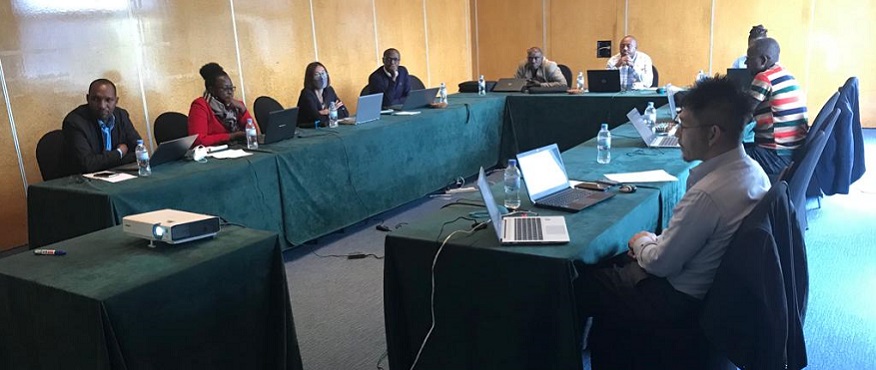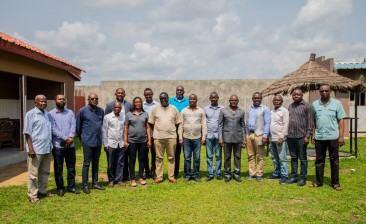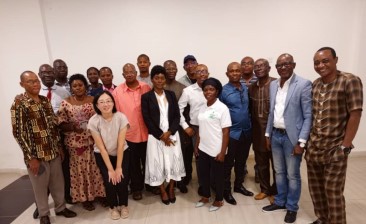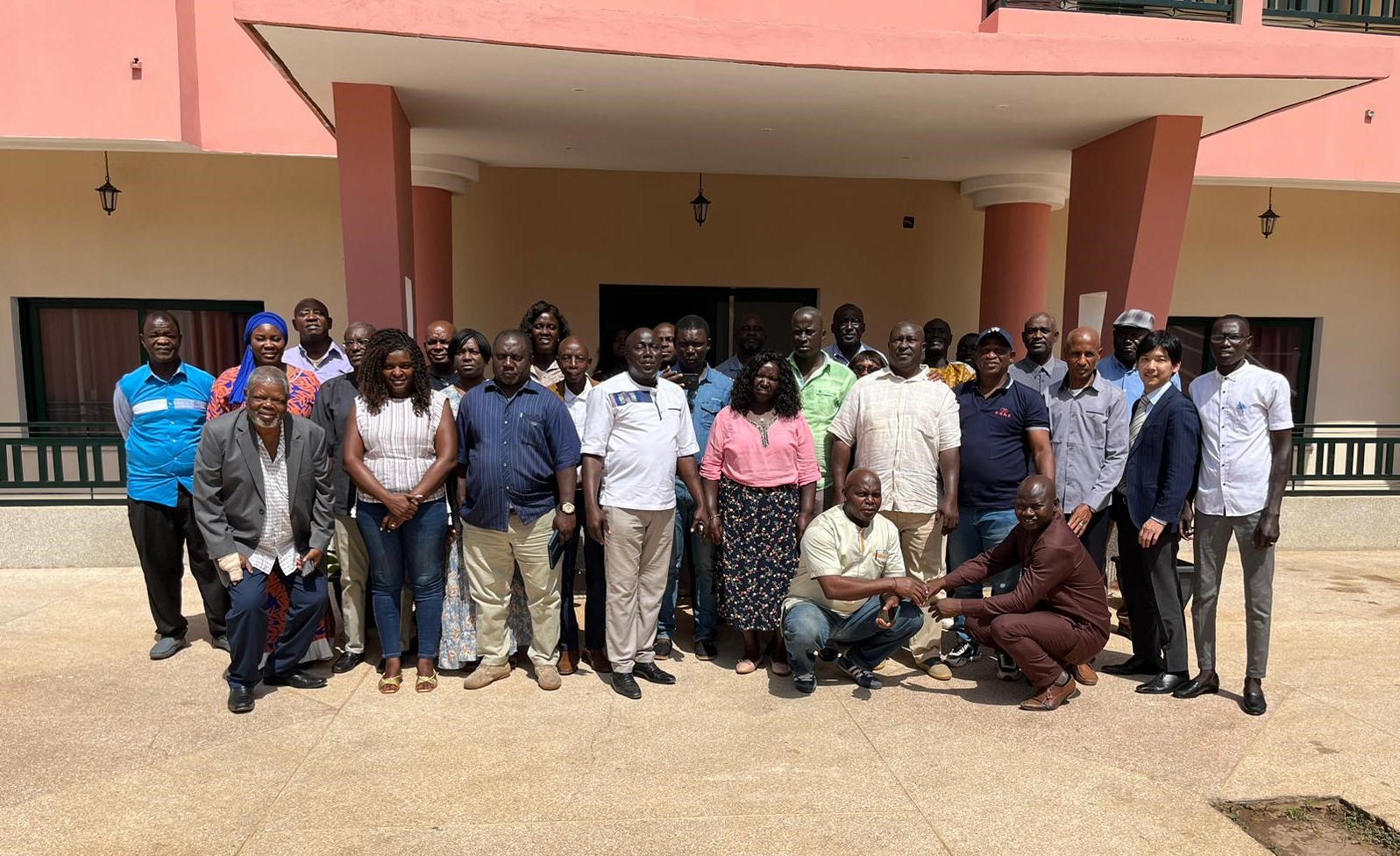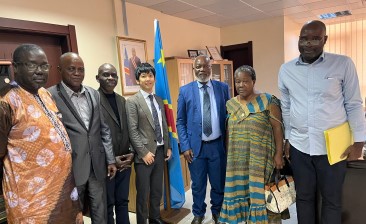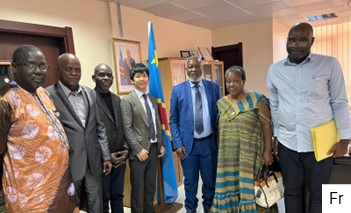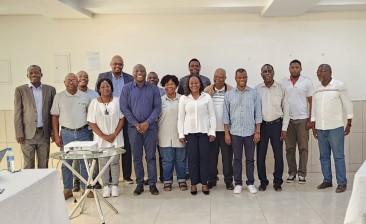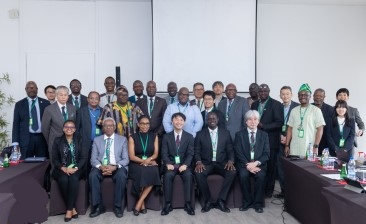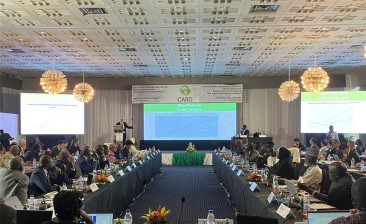Rwanda, February 2022
CARD Working Week on Monitoring and Evaluation of Second National Rice Development Strategies in Rwanda
Rice sector development in Rwanda has a significant bearing on national food security and the country’s ambition on social transformation through agriculture. Current deficit in domestic rice production however compels consumer markets to import up to about half of annual demand from elsewhere. This has prompted the Government of Rwanda (GoR) to set steering towards self-sufficiency in rice production as a goal under its second National Rice Development Strategy (NRDS-II; 2020-2030).
Under its first NRDS (NRDS-I; 2009-2018), Rwanda nearly doubled its local paddy grain (raw rice) production from 66,000 tons in 2009 to 113,880 tons by 2018. Yet importation of milled rice also had surged from 25,690 tons (worth 5 million USD) to 119,419 tons (worth 61.4 million USD) during the same period. Like in several of the other CARD member countries; one of the key shortcomings during the implementation of first NRDS (NRDS-I; 2009-2018) in Rwanda was lack of appropriate tracking mechanism(s) for monitoring and evaluation of progress in rice sector development that could help course-correct the conceived strategic interventions and coordination.
It is in this context that CARD Secretariat proposed a monitoring & evaluation framework for second NRDS-II framework, that would allow member countries and the CARD initiative at large, to periodically ascertain advancements in overall rice sector development during their implementation under each of the four guiding principles viz., Resilience (R), Industrialization (I), Competitiveness (C), and Empowerment (E).
Following endorsement of this new M&E framework by CARD stakeholders at eighth General Assembly (October, 2021); CARD Secretariat drafted Terms of Reference (ToR) for hiring a national consultant in Rwanda to conduct initial surveys and collect the necessary data on the proposed indicators. The draft was circulated amongst Rwanda’s NRDS taskforce members and JICA-Rwanda office, seeking their engagement in finalizing the ToR and overseeing the in-country M&E process.
Subsequently, the NRDS taskforce requested for technical discussions and clarifications on the indicators and the proposed ToR amongst the members, JICA officials and Regional Consultant of CARD. For this purpose, a 3-day workshop was organized by the taskforce and JICA-Rwanda office in Kigali between 8th and 10th of February, 2022. Key outputs from this meeting are summarized below: –
CARD activity and the results
The workshop was organized in a hybrid mode, wherein the taskforce members and Mr. Takanori Satoyama, JICA’s policy advisor for Rwanda’s Ministry of Agriculture and Animal Resources (MINAGRI) physically attended the meetings at Hotel De Milles Collins in Kigali, and JICA-Rwanda officials and Regional Consultant of CARD joined the meeting virtually via online platform.
Expected outputs from the workshop included (1) a consensus on the list of indicators that will be deployed for M&E of rice sector development in Rwanda and (2) review of ToR for hiring national consultancy services in Rwanda. The Regional Consultant of CARD first provided an overview to the participants on key desirable characteristics of the indicators that shall help measure the progress on NRDS-II implementation; and gave description of the indicators proposed by the CARD Secretariat for tracking the progress under 5 different categories viz., overall, resilience, industrialization, competitiveness, and empowerment. Using extracts from Rwanda’s NRDS-II document, the consultant refreshed the participants on the expected outputs under four strategic axes of the Rwanda’s NRDS-II document.
Taking the lead on discussions on indicators, Mr. Takanori Satoyama recalled synergy between the four strategic axes of Rwanda’s NRDS-II and that of Rwanda’s fourth phase of Program for Sustainable Transformation of Agriculture (PSTA-IV). The participants brainstormed on the relevance, appropriateness, and feasibility of collecting information on the indicators proposed in the draft version of ToR for national consultancy services.
Rwanda’s taskforce generally agreed to the indicators under Overall (O) and Resilience (R) categories proposed by the CARD Secretariat. For tracking progress on industrialization (I), competitiveness (C) and Empowerment (E) categories however, the taskforce members suggested amendments on CARD’s suggested indicators, as they felt that the context of rice sector development in Rwanda is slightly different from a generalized context of other CARD member countries (table 1).
The participants redefined the modified indicators and suggested potential sources and avenues for collecting the relevant data and information. Since baseline figures for several of the agreed indicators are not readily available, the participants suggested that data collected through the proposed consultancy services shall be set as benchmarks. Where targets are not already mentioned in the NRDS-II document, the participants set anew mid-term (2024) and long-term (2030) targets for each indicator (table 1).
Table 1: Description of indicators agreed by participants for monitoring and evaluation of rice sector development in Rwanda
| Category of indicator | Indicators | Source, Method & Geographic location, samples of data collection | Target | |
| 2024 | 2030 | |||
| Overall | O-1. Total Quantity of paddy production | Secondary data from SAS of NISR on line, and RRA through interviews | 254,440 MT | 390,000 MT |
| O-2. Total area harvested | 50,888 ha | 60,000 ha | ||
| O-3. Yield per unit area | 5.0t /ha | 6.5t / ha | ||
| O-4. Self-sufficiency rate | 82% | 90% | ||
| Resilience | R-1. Area under irrigation – Areas harvested with rice | Secondary data SAS of NISR online | 50,888 ha | 60,000 ha |
| R-2. Quantity of seeds of resilient varieties – The amount of resilient varieties (biotic and abiotic stresses) produced | Primary data; Seed producing companies through RICA, and Seed Program RAB | 500 MT of seeds | 600MT of seeds | |
| Industrialization | I-1. Level of milling sector upgrading | |||
| I-1.1. The number of millers who operate at more than 70% of their milling capacity | 5 | 26 | ||
| I-1.2. The number of mills that practice activities for value addition (grading-efforts to produce higher grade, production of rice processed products, successful branding) | Primary data; RFRM and Millers; Interview and Survey | 5 | 10 | |
| I-2. Level of mechanization in production – The percentage of farmers mechanizing rice production activities (land preparation, harvesting, post-harvesting) | Primary data; Cooperatives; sample survey | 10% (to be broken down) | 20% (to be broken down) | |
| Competitiveness | C-1. Share of local rice in the market – rural and urban markets through sample surveys | Secondary data from SAS of NISR on line, and RRA through interviews (import) | 82% | 90% |
| C-2. Quantity of seeds of varieties with marketable traits – Quantity of seeds of varieties with consumer-preferred traits produced and sold | Primary data; Seed producing companies through RICA, and Seed Program RAB | 250 MT | 300MT | |
| Empowerment | E-1. Smallholder farmers/cooperatives’ accessibility to “financial” services – Percentage of farmers, among those in need, who used/accessed formal financial services for rice production purposes in the last 12 months | Primary data; selected cooperatives through FUCORIRWA,; Interview/survey | 40% | 80% |
| E-2. Smallholder farmers’ accessibility to technical training or services – The number/ percentage of farmers who received any rice related trainings and/or technical advisory services in the last 12 months | Primary data; selected cooperatives through FUCORIRWA; survey | 60% | 100% | |
The participants also discussed the ToR drafted by the CARD Secretariat and made several suggestions. Key modifications proposed by the taskforce members on the ToR include the following: –
Number of assistants to team leader shall be increased from 2 to 4 with 30 person days each
Number of man-days under the consultancy services shall be increased to a total of 180 (60 for the team leader and 120 for the 4 assistants)
Duration of contract shall be increased to 5 months
Taskforce members expressed their desire to meet with national consultant through at least two different stages of services –
at inception stage, to verify and agree on methodology of data collection, and
at final reporting stage, to validate the findings of national consultant.
If funding permits, the taskforce members would like to organize a CARD working week (annual review meeting) so that it coincides with final reporting by national consultant. Through such a proposed working week, the taskforce would like to engage other wider stakeholders (including academia, development partners, Ministry, Cooperatives, Private sector representatives, and others) for sharing and further apprising the progress made in rice sector development.
Way forward
Rwanda’s taskforce members has accepted their responsibilities and agreed to lead the process of monitoring and evaluation of rice sector development in Rwanda. JICA-Rwanda office will organize national consultancy services for collection of data for each of the indicators, after agreeing on the suggested modification over them between the taskforce and CARD Secretariat. The recruitment/procurement process of national consultancy services is expected to begin in April 2022.
